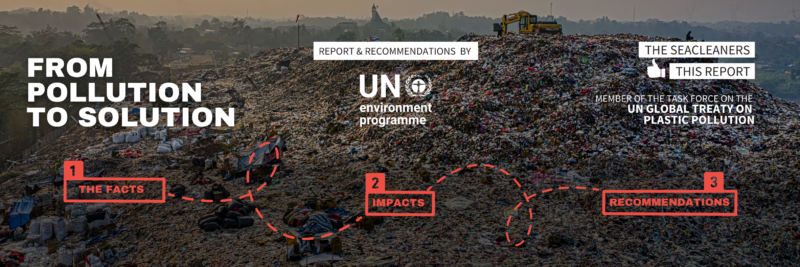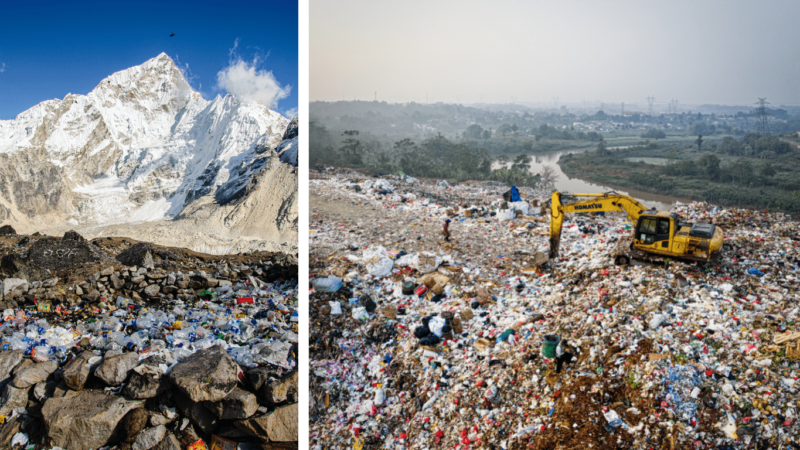50 kg of plastic per meter of coast in the world in 2040: from pollution to solution, the striking report of the United Nations Environment Program
Awareness and education
Plastic pollution
Science
8 December 2021

The United Nations Environment Programme has published a comprehensive overview of plastic pollution and marine litter entitled "From Pollution to Solution: A Global Assessment of Marine Litter and Plastic Pollution."
The study aims to provide a comprehensive update of current data and research, identify gaps in knowledge, and concludes with a recommendation for global strategies to address plastic pollution.
This report is particularly important as it will inform the adoption of priority actions at the United Nations Environment Assembly in 2022. At that time, member countries will meet to set the course for global cooperation on plastic pollution control.
As a member of the task force on the UN Global Treaty on Plastic Pollution, The SeaCleaners decodes for you the key points of the report, as well as UNEP’s 8 tracks to curb plastic pollution in the oceans.
“This assessment provides the strongest scientific argument to date for the urgency of action, and for the implementation of collective measures to protect and restore our oceans from source to sea.”
50 kilograms of plastic per meter of coastline in the world in 2040: an update of plastic pollution figures
Plastic is everywhere, from the depths of the Mariana Trench to the top of Mount Everest.
Today, plastic represents the largest, most harmful and persistent fraction of marine pollution, accounting for at least 85% of all marine litter.
Yet, if we don’t change, plastic pollution as we experience it today is a phenomenon that is just beginning.
In 2019, plastic production continued to grow to 368 million tons, equivalent to the weight of humanity. At this rate, the production volume will exceed 1 billion tons (1 ,100 million) per year by 2050.
The UNEP report contrasts the staggering volumes of plastic production with the reality of a recycling industry that is struggling to keep up with this growth: today, less than 10% of the plastic produced is recycled.
Without urgent action, the 11 million tons of plastic that currently enter the ocean each year will triple in the next 20 years.
This would mean that between 23 and 37 million tons of plastic would enter the ocean each year by 2040.
This is equivalent to 50 kilograms of plastic per meter of coastline worldwide.

Plastic waste represents a serious threat to all marine life, exposes human health, while influencing the climate.
Turtles, fish, birds, marine mammals including endangered species such as right whales in the North Atlantic… As we know, marine biodiversity is the first victim of plastic pollution. All marine life is exposed to the dangers of plastic pollution: suffocation, mutilation, starvation, but also intoxication. Pieces of plastic have been found in the digestive systems of many aquatic organisms, including all species of sea turtles and nearly half of the seabird and marine mammal species surveyed.
Plastic pieces have been found in the digestive systems of many aquatic organisms, including all species of sea turtles and nearly half of the seabird and marine mammal species surveyed.
The report also highlights the risks to humans: while the full extent of the impact on human health is not yet known, there is substantial evidence that plastic chemicals can enter the human body: microplastics have been found in our lungs, liver, spleen and kidneys, as well as in the placenta of newborns.
Chemicals commonly linked to plastics have been associated with endocrine disruption, developmental disorders, reproductive abnormalities and cancer.
Throughout its life cycle, plastic perpetuates the vicious cycle of CO2 emissions, affecting global warming. Plastic is a product of petrochemistry, and the more plastic we produce, the more CO2 we consume. Between its production, degradation in its natural state, incineration or recycling, it is estimated that plastic accounts for 19% of the total emissions allowed under the Paris Agreement in 2040 to limit warming to 1.5°C.
Plastic pollution severely affects the ecosystems that absorb this CO2 and weaken their ability to regulate the climate: the ocean warms, acidifies and becomes chemically unbalanced. Mangroves, seagrass beds, shores and coral reefs, the four coastal ecosystems that store the most carbon and act as natural barriers to rising seas and storms, are under great pressure from land-based plastic pollution because of their proximity to rivers.

Not everyone is equal when it comes to plastic pollution
UNEP also points to an often overlooked element of plastic pollution: it is a major social, economic and health inequality. And we are not all equal when it comes to the effects of plastic pollution.
Richer countries produce more plastic waste, which is often sent to less developed countries. In developing countries, local communities lack the structures and funding to manage the environmental, health, social and cultural burdens of plastic pollution.
Plastic pollution of the coasts contributes to perpetuating these inequalities by jeopardizing access to clean water, pest and disease control, and economic activities such as fishing and aquaculture, resulting in billions of dollars in socio-economic losses, mostly borne by the most vulnerable countries.
According to the report, marine plastic pollution reduces valuable marine ecosystem services by at least $500 billion to $2.5 trillion per year, in addition to other social and economic losses to the tourism and shipping sectors.
In addition, the report estimates that by 2040, plastic waste could present an annual financial risk of US$100 billion to businesses that will have to bear the costs of waste management.

Eight ways to change the current trajectory of plastic pollution
“While the amount of marine plastic we have to deal with is so large, science shows us that most of the solutions we need to put in place already exist.”
There is no single solution, but we can change the trajectory of plastic waste by reducing our consumption, implementing regulations, supporting innovation and developing appropriate infrastructure.
Here are the 8 recommendations of UNEP:
- Improve and develop the presence of waste management systems to optimize recycling
- Improve circularity by promoting sustainable consumption and production practices along the plastics value chain.
- Mobilize consumers to support the fight against plastic pollution in order to influence the market and inspire behavioral change.
- Phase out unnecessary, avoidable and most problematic plastic items and replace them with other materials, products and services.
- Manage the consequences through effective tracking to identify sources, quantities and fate of plastics.
- Improve and strengthen governance at all levels.
- Build knowledge and track effectiveness through scientific discipline.
- Support funding through technical assistance and capacity building.
This report is important to us because it validates The SeaCleaners’ strategy for action against marine plastic pollution.
The SeaCleaners is working at its own level to implement the conclusions of the UNEP, as a member of the Task Force on the UN Global Treaty on Plastic Pollution.
This working group will have the difficult task of transforming its wishes into concrete actions and binding measures for all actors in the chain, in order to finally put a stop to plastic pollution of the oceans. See you in Nairobi in February 2022 for the UNEP General Assembly.
To learn more about the UNEP report “From Pollution to Solution: a global assessment of marine litter and plastic pollution“
To know more, read the Take-aways report of the roundtable “An Abyss of Plastic Wisdom: a solutions-oriented dialogue“.